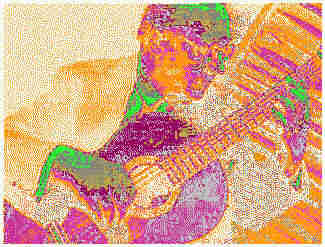Andres Segovia, the Spanish guitarist who has been received with acclaim in many countries of Europe as the leading exponent of an instrument which has heretofore had little consideration as a vehicle for the interpretation of serious music, will make a tour of the principal cities of the United States next season, according to an announcement of his managers a few days ago. The ever-growing popularity of the harpsichord, to which the art of Wanda Landoska has contributed so largely, has demonstrated to a striking degree the power of the plucked string as a medium of musical expression; but it remained for Senor [sic] Segovia, above all other guitarists, to show that his instrument has also astonishing scope in the felicitous interpretation of classic and modern music of a high order through analogous means. Far from being monotonous and suited only for an accompaniment to a sentimental serenade, European critics have agreed that the guitar possesses a range of color and tone quality that in the hands of Senor Segovia at times surpasses that of the harpsichord.
"Senor Segovia’s guitar," says The London Times, reviewing a recent recital, "with its small compass and a tone so delicate that a careless cough among the audience will obliterate it altogether, yet introduces us to gradations of quality which seem infinite. The voices of a fugue stand out from one another; the episodes of a sonata are distinguished in timbre as sharply as the registers of the harpsichord or of the organ can distinguish them. The ear is alert to detect the finest nuances and is quickened by the need for apprehending them in the moment of their execution. The freely vibrating string after the moment of attack may play a contributory part, especially in the glissando, which is one of Senor Segovia’s most fascinating effects; but that is only a very small part as compared with what the actual touch of the fingers of the right hand produces."
"This instrument, at any rate when played by an artist like Senor Segovia, is capable of many different tone colors, according to the place where the strings are plucked and the manner of their plucking. This directness of touch makes possible subtleties which even the violin cannot approach, still less the harpsichord, which is its nearest relation in the matter or timbre. Its tone is sweet and its style intimate, but what is most surprising is its capacity for phrasing; and it is the perfection of phrasing which gives the measure of Senor Setgovia as an artist."
The guitar is perhaps the nearest thing to the lute in practical music today, and may well shed some light upon. it. Just as Bach wrote phrases for the organ, notably in the trio sonatas, which seem to demand the breath of the player on the flute or oboe for their proper articulation, so for the clavier he wrote as though the intimate touch of the finger on the string were at his command. Senor Segovia usually includes on his programs a groups of compositions by Bach, preludes, fugues, gavottes, or minuets, which were, contrary to popular belief, originally written for the lute. The performance of these works at a recent recital, says The Telegraph, "was delicate and lovely beyond words, and the frequent resemblance in timbre to that of the clavichord made us quite contented to go on listening to the guitar."
Many modern Spanish words, though written for the piano, have a quality which lends them with singular appropriateness to performance on the guitar. "Works such as ‘Granada’ or "Cadiz,’ by Albeniz, "say G. Jean-Aubry, "or the deservedly famous dances of Granados have, when played on the guitar, such a variety, such an authenticity of tone, that their performance on the piano can only disappoint us now."
Artists like Casals, Thibaud, Harold Bauer and Gabrilowitsch, according ot Segovia’s American representatives, have urged the management repeatedly to arrange an American tour for him, declaring that he will bring about here a renascence of the guitar as he has done in Europe. His first appearance will take place at the Town Hall early next January after which he will visit other cities including Boston and Chicago. He has spent the summer at Evien-les-Bains, whence came word last week of his agreement to make the forthcoming tour of the United States.
